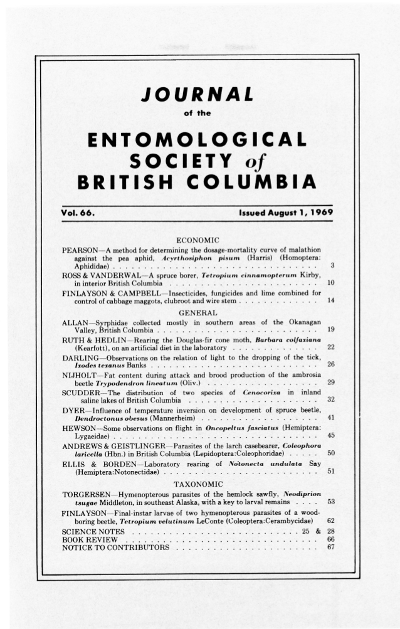Observations on the relation of light to the dropping of the tick, <i>Ixodes texallus</i> Banks
Keywords:
<i>Ixodes texallus</i>Abstract
Six ferrets were infested with large numbers of nymphs or larvae of the tick <i>Ixodes texallus</i> Banks. The animals were caged separately and subjected to various regimes of continuous light and darkness, from 9 days to 5, 4, and 2 days, and normal photoperiods. Nearly all the engorged ticks dropped from the hosts in the dark.
References
Balashov, Y.S. 1954. Peculiarities of the daily rhythm of dropping of engorged female Ixodes persulcatus from cattle. DokJ. Akad. Nauk. USSR (N.S.) 98(2):317-319.
George, J.E. 1963. The circadian rhythm of "drop-off" of engorged Haemaphysalis leporispalustris from rabbits. Acarologia, fasc. h.s. 1964, pp. 343-349 (C. R. 1st Congr. Int. d'Acarologie, Fort Collins, Col., U.S.A. 1963).
Hooker, W.A. 1908. Life history, habits and methods of study of the Ixodoidea. J. Econ. Entomol. 1:34-51.
Kheisin, E.M. and L.E. Lavrenenko. 1956. Duration of blood-sucking and diurnal rhythm of nutrition and dropping of females of Ixodes ricinus L. Zool. Zh 35(3):379∑383. (Translated from Russian).
Kitaoka, S. 1962. Physiological and ecological studies on some ticks. VIII. Diurnal and nocturnal changes in feeding activity during the blood-sucking process of Haemaphysalis bispinosa. Nat. Inst. Anim . Hlth. Quart. 2(2):106-111.
Kohls, G.M. 1937. Tick rearing methods with special reference to the Rocky Mountain wood tick, Dermacentor andersoni Stiles. Culture methods for invertebrate animals. Cornell Univ. Press (Comstock) Ithaca, N.Y.
Downloads
Published
Issue
Section
License
Authors who publish with the Journal of the Entomological Society of British Columbia agree to the following terms:
-Authors retain copyright and grant the journal right of first publication with the work simultaneously licensed under a Creative Commons Attribution License that allows others to share the work with an acknowledgement of the work's authorship and initial publication in this journal.
-Authors are able to enter into separate, additional contractual arrangements for the non-exclusive distribution of the journal's published version of the work (e.g., post it to an institutional repository or publish it in a book), with an acknowledgement of its initial publication in this journal.
-Authors are permitted and encouraged to post their work online (e.g., in institutional repositories or on their website) prior to and during the submission process, as it can lead to productive exchanges, as well as earlier and greater citation of published work (See The Effect of Open Access).


